We used to examining operation of professional accelerators in DCC (Digital
Content Creation) applications. But their range of application also includes
a wide range of other types of programs called CAD. CAD applications are
mostly meant for professional designers and engineers building models of
objects; in short, such applications substitute usual whatman paper and
a drawing board. For CAD applications the WIREFRAME mode of an accelerator
is the most important; we examined this mode in the tests of DCC applications
as well, but in CAD it plays the leading role. For example, if a drawing
is untidy will the examiner accept it? That is why hardware line acceleration
is so important in operation with such systems. The idea of this mode is
to render simple lines. Our test will show how different accelerators cope
with this task, because a lot of them support the hardware line acceleration
including anti-aliasing, which lets users hope for high-quality line rendering
without speed losses.
Quite often CAD applications are called Mechanical CAD, we will call
them simply CAD. Almost all professional accelerators are certified for
most popular CAD applications, which means that a given accelerator passed
the test in a certain application and usage of a given accelerator is confirmed
by a manufacturer of a given CAD package.
Today we use a CAD package called Solid
Edge from Unigraphics.
Unfortunately, its version is not the latest - 10. The package itself doesn't
have any benchmarks for testing accelerators, but the experts from http://www.spec.org/
released a special suite exactly for this version, which can be downloaded
from here
after filling in a simple blank.
There is nothing much we can say about the test. It allows measuring
performance of a system regarding CPU, Graphic, file system etc. But we
are interested exactly in the video system performance. Apart from the
Solid Edge packet this test requires installation of the Microsoft Office,
removing marks from the disc and not touching the mouse. That is why, having
turning the mouse head over heels we start the measurements. The test is
based on operation of scripts. Choose a mode, and a certain script will
start running; it will open a precalculated mode of an object and fulfill
certain instructions, for example, rotation, twisting or scaling.
For more detailed information on the SPECaps project go here.
Testbed:
-
Intel Pentium 4 2200 MHz (l2=512Kb)
-
ASUStek P4T-E mainboard (on i850)
-
512MB RDRAM PC800
-
Quantum FB AS 20GB hard drive.
-
ViewSonic P810 and ViewSonic P817E (21") monitors.
The following professional cards were used in the tests:
As you can see, the most complete lines of video cards are ATI FireGL and
Quadro of NVIDIA. Besides, I also included some gaming cards:
-
NVIDIA GeForce2 TI
-
NVIDIA GeForce3 128MB
-
NVIDIA GeForce4 MX440
-
NVIDIA GeForce4 MX460
-
NVIDIA GeForce4 Ti4600
-
ATI RADEON 7500
-
ATI RADEON 8500
-
ATI RADEON 9000
-
SoftQuadro DCC 128MB
-
SoftQuadro4 750
-
SoftQuadro4 900
The following drivers were installed:
The ATI RADEON family was tested with the 6118 version, the ATI FireGL2
- ver.2088, the ATI FireGL8x00 - ver.3036. The NVIDIA based cards were
tested with the latest official available version - 3082. The 3Dlabs
Wildcat VP870 ran under the ver. 0423. The VP870 was estimated both
in the maximum geometry mode and in the maximum texture one.
Why have I included gaming cards into the tests? I got a lot of letters
where you ask me to use them as well because they are much cheaper and
more widespread.
The tests were carried out under the Windows XP Professional. The drivers
(system ones and according to devices) and the Solid Edge 10 packet
were installed on the virgin operating system. The Vsync mode was disabled,
the resolution was set to 1280x1024x32bit (as the test required), and
an optimization in the OpenGL for a given application, here it's Solid
Edge, was enabled when possible. If it wasn't possible to use such optimization
the OpenGL defaults were set. After that we installed the SPECaps packet
with a batch of tests for the Solid Edge. Here we chose the one which
measured the video system performance.
All cards seemed to fulfill the tasks identically. No artifacts were
noticed, but the test required only rendering of lines (wireframe mode)
and Solid Shaded, which is not a too complicated problem for modern
accelerators.
The benchmark tests the accelerators in the following modes: Solid Shading,
Wireframe and Solid Shading Textures. It measures time and fps a given
scene needs for rendering. After that the test gives the score.
So, the first test is carried out in the Solid Shading mode. SE stands
for optimization enabled in the OpenGL for Solid Edge. This optimization
can be used on almost all professional cards. None of the cards, professional
or game, made us complain of the rendering quality. All produced identical
quality.
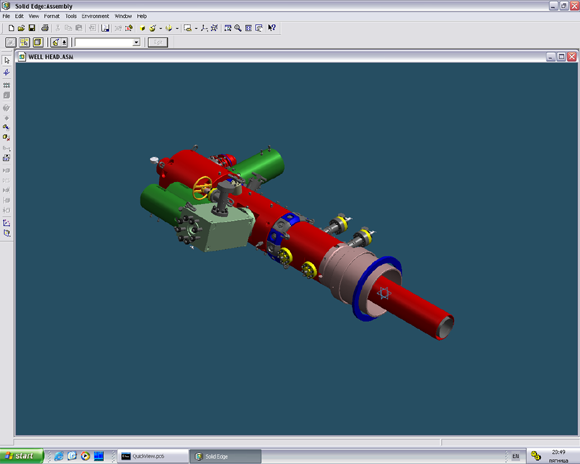
Now let's estimate the speed of rendering:
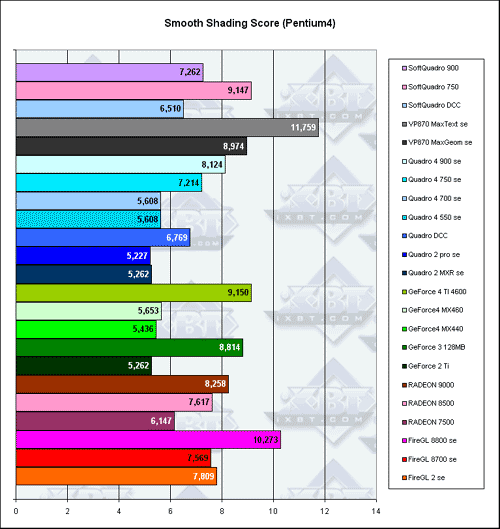
Well, while the professional FireGL 8800 of ATI outscores the gaming cards
of this company, the NVIDIA's gaming GeForce 4 Ti 4600 card beats its professional
solutions. The situation is intriguing. At the same time, the 3Dlabs Wildcat
VP870 is an absolute leader, though the victory in the texture optimization
mode looks strange. But the wireframe mode comes with a precalculated texture.
That is why the victory exactly in this mode becomes correct. Besides,
the gaming cards are able to work with the Solid Edge! Sometimes they even
outperform the professional ones!
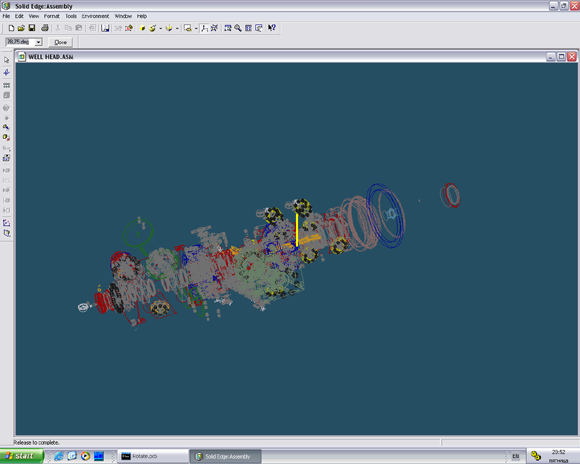
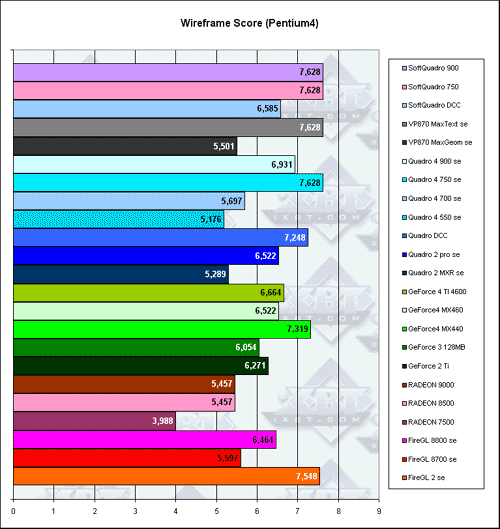
The second test is a pure wireframe mode. The hardware line acceleration
has the most considerable effect here. It's interesting that the oldest
professional card FireGL2 is leading here. It doesn't run far away from
the other cards, but the breakthrough from the latest ATI's card is great.
The NVIDIA's professionals perform according to the price and performance
levels, only the Quadro 4 900 doesn't fit in here. The higher score of
the Wildcat VP870 in the texture mode in comparison to the geometry mode
looks odd, probably, because of the drivers. The gaming models show quite
good results, except the pure outsiders.
And the last video test is SmoothShading Textures
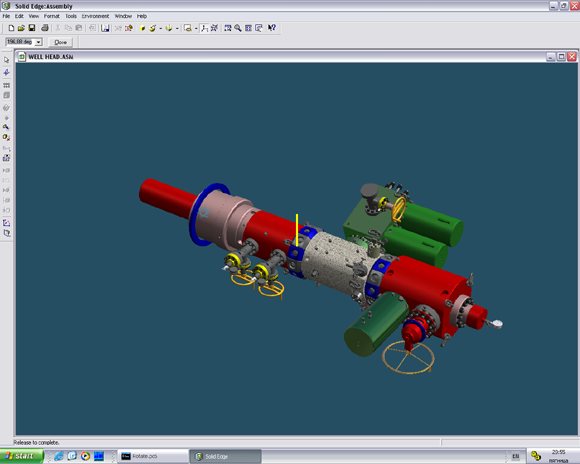
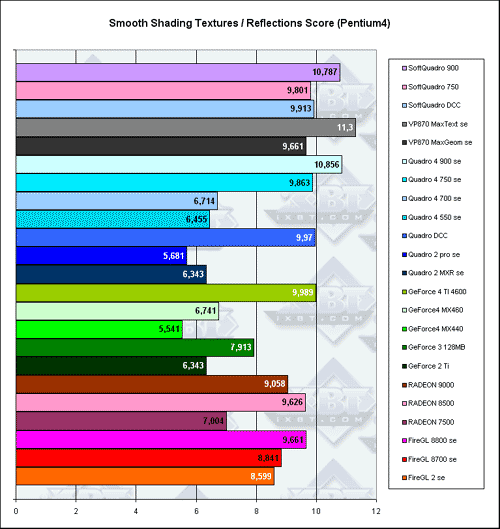
The Wildcat VP870 takes the palm here. It is followed by the Quadro4 900
XGL, the most powerful NVIDIA's solution; the third position is taken by
the SoftQuadro 4. The Geforce 4 ti 4600 looks much weaker than both Quadros;
it means that it's possible to make an almost professional card out of
a gaming one just by altering the drivers. Among the ATI's solutions the
FireGL 8800 looks the best one; the gaming RADEON 8500 is close on the
heels. The outsiders are the same.
Now, when we studied all the cards in separate tests, it's time to look
at the whole picture:
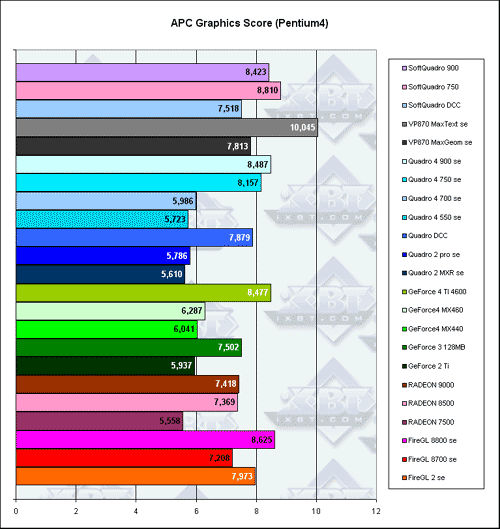
Well, there is nothing surprising in this test. I just what to say that
the professional cards cope much better with the tasks than the gaming
solutions, that is why their price is justifiably higher. Nevertheless,
you shouldn't treat all cards equally, even within a professional class.
Depending on speeds and capabilities they have different price tags and
different preferable areas of application. Our tests have revealed the
leaders. But do remember that the Solid Edge is just one of a big army
of the automatic designing systems.
Additional test
During our testing NVIDIA released a new driver version, that is why we
had to retest all NVIDIA-based cards with this version which, according
to NVIDIA, provides better performance in SPECviewperf which lets us hope
for higher results in real applications. So, here is the last diagram.
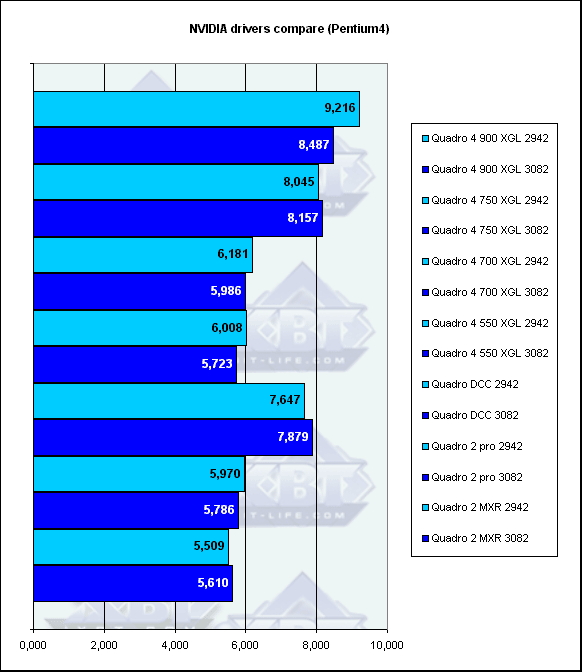
The light blue bars show the results obtained with the previous version
- 29.42, the dark blue ones - with 30.82. On the whole, the situation is
worse. Some tests have improved the scores, but have you noticed which
cards? Quadro DCC ? It has too few certified applications. Quadro 2 MXR?
I don't think the new version was optimized exactly for this card. Quadro
4 750? The difference is negligible. I can say that the new drivers are
worse than the old ones. Nevertheless, the overall difference between the
versions is not great, though the ver.29.42 is preferable.
That's all about testing in the CAD systems. New products, new accelerators,
new drivers will fill up our future reviews. And take into account that
optimization of drivers affects much modern 3D acceleration and especially
professional modeling.
Write a comment below. No registration needed!








